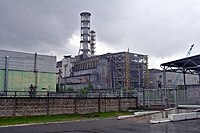
Back Tsjernobil-kernramp Afrikaans Katastrophe von Tschernobyl ALS كارثة تشيرنوبل Arabic كارثه تشرنوبل ARZ চাৰ্ন'বিল বিপৰ্যয় Assamese Accidente de Chernóbil AST Çernobıl faciəsi Azerbaijani چرنوبیل فاجیعهسی AZB Чарнобыльская катастрофа Byelorussian Чарнобыльская катастрофа BE-X-OLD
 Reactor 4 several months after the disaster. Reactor 3 can be seen behind the ventilation stack. | |
 | |
| Date | 26 April 1986 |
|---|---|
| Time | 01:23 MSD (UTC+04:00) |
| Location | Chernobyl Nuclear Power Plant, Pripyat, Chernobyl Raion, Kiev Oblast, Ukrainian SSR, Soviet Union (now Vyshhorod Raion, Kyiv Oblast, Ukraine) |
| Type | Nuclear and Radiation accident |
| Cause | Reactor design and operator error |
| Outcome | INES Level 7 (major accident) |
| Deaths | 2 killed by debris (including 1 missing) and 28 killed by acute radiation sickness. 15 terminal cases of thyroid cancer, with varying estimates of increased cancer mortality over subsequent decades (for more details, see Deaths due to the disaster) |
| Chernobyl disaster |
|---|
 |
The Chernobyl disaster began on 26 April 1986 with the explosion of the No. 4 reactor of the Chernobyl Nuclear Power Plant near the city of Pripyat in northern Ukraine, near the Belarus border in the Soviet Union.[1] It is one of only two nuclear energy accidents rated at the maximum severity on the International Nuclear Event Scale, the other being the 2011 Fukushima nuclear accident. The response involved more than 500,000 personnel and cost an estimated 18 billion rubles (about $68 billion USD in 2019).[2] It remains the worst nuclear disaster in history,[3][4] and the costliest disaster in human history, with an estimated cost of $700 billion USD.[5]
The disaster occurred while running a test to simulate cooling the reactor during an accident in blackout conditions. The operators carried out the test despite an accidental drop in reactor power, and due to a design issue, attempting to shut down the reactor in those conditions resulted in a dramatic power surge. The reactor components ruptured, lost coolants, and the resulting steam explosions and meltdown destroyed the containment building, followed by a reactor core fire that spread radioactive contaminants across the USSR and Europe.[6] A 10-kilometre (6.2 mi) exclusion zone was established 36 hours after the accident, initially evacuating around 49,000 people. The exclusion zone was later expanded to 30 kilometres (19 mi), resulting in the evacuation of approximately 68,000 more people.[7]
Following the explosion, which killed two engineers and severely burned two others, an emergency operation began to put out the fires and stabilize the reactor. Of the 237 workers hospitalized, 134 showed symptoms of acute radiation syndrome (ARS); 28 of them died within three months. Over the next decade, 14 more workers (nine of whom had ARS) died of various causes mostly unrelated to radiation exposure.[8] It is the only instance in commercial nuclear power history where radiation-related fatalities occurred.[9][10] As of 2011, 15 childhood thyroid cancer deaths were attributed to the disaster.[11] The United Nations Scientific Committee on the Effects of Atomic Radiation estimates fewer than 100 deaths have resulted from the fallout.[12] Predictions of the eventual total death toll vary; a 2006 World Health Organization study projected 9,000 cancer-related fatalities in Ukraine, Belarus, and Russia.[13]
Pripyat was abandoned and replaced by the purpose-built city of Slavutych. The Chernobyl Nuclear Power Plant sarcophagus, completed in December 1986, reduced the spread of radioactive contamination and provided radiological protection for the crews of the undamaged reactors. In 2016–2018, the Chernobyl New Safe Confinement was constructed around the old sarcophagus to enable the removal of the reactor debris, with clean-up scheduled for completion by 2065.[14]
- ^ "Accident of 1986". Chornobyl NPP. Retrieved 14 July 2022.
- ^ "Chernobyl: Assessment of Radiological and Health Impact, 2002 update; Chapter II – The release, dispersion and deposition of radionuclides" (PDF). OECD-NEA. 2002. Archived (PDF) from the original on 22 June 2015. Retrieved 3 June 2015.
- ^ "The Chornobyl Accident". United Nations Scientific Committee on the Effects of Atomic Radiation. Retrieved 19 September 2023.
- ^ Steinhauser, Georg; Brandl, Alexander; Johnson, Thomas E. (2014). "Comparison of the Chernobyl and Fukushima nuclear accidents: A review of the environmental impacts". Science of the Total Environment. 470–471: 800–817. Bibcode:2014ScTEn.470..800S. doi:10.1016/j.scitotenv.2013.10.029. PMID 24189103.
- ^ Samet, Jonathan M.; Seo, Joann (21 April 2016). The Financial Costs of the Chernobyl Nuclear Power Plant Disaster: A Review of the Literature (PDF) (Report). USC Institute on Inequalities in Global Health. pp. 14–15. Retrieved 8 May 2024.
- ^ McCall, Chris (April 2016). "Chernobyl disaster 30 years on: lessons not learned". The Lancet. 387 (10029): 1707–1708. doi:10.1016/s0140-6736(16)30304-x. ISSN 0140-6736. PMID 27116266. S2CID 39494685.
- ^ Steadman, Philip; Hodgkinson, Simon (1990). Nuclear Disasters & The Built Environment: A Report to the Royal Institute. Butterworth Architecture. p. 55. ISBN 978-0-40850-061-6.
- ^ Wagemaker, G.; Guskova, A. K.; Bebeshko, V. G.; Griffiths, N. M.; Krishenko, N. A. (1996). "Clinically Observed Effects in Individuals Exposed to Radiation as a Result of the Chernobyl Accident". One Decade After Chernobyl: Summing up the Consequences of the Accident, Proceedings of an International Conference, Vienna.: 173–198.
- ^ Zohuri, Bahman; McDaniel, Patrick (2019). Thermodynamics in Nuclear Power Plant Systems (2nd ed.). Springer. p. 597. ISBN 978-3-319-93918-6.
- ^ "Chernobyl Accident 1986 – World Nuclear Association". world-nuclear.org. 26 April 2024. Retrieved 9 May 2024.
- ^ "Chernobyl 25th anniversary – Frequently Asked Questions" (PDF). World Health Organization. 23 April 2011. Archived (PDF) from the original on 17 April 2012. Retrieved 14 April 2012.
- ^ "UNSCEAR assessments of the Chernobyl accident". unscear.org. Archived from the original on 13 May 2011. Retrieved 13 September 2007.
- ^ "World Health Organization report explains the health impacts of the world's worst-ever civil nuclear accident". World Health Organization. 26 April 2006. Archived from the original on 4 April 2011. Retrieved 4 April 2011.
- ^ "Chernobyl nuclear power plant site to be cleared by 2065". Kyiv Post. 3 January 2010. Archived from the original on 5 October 2012.